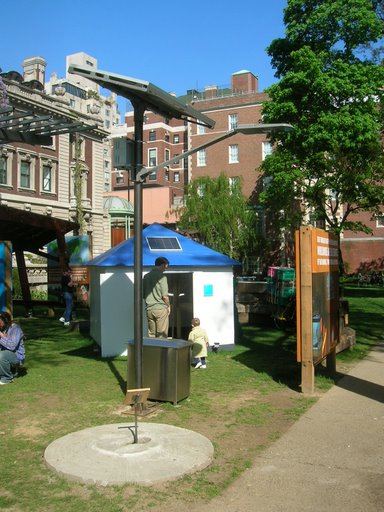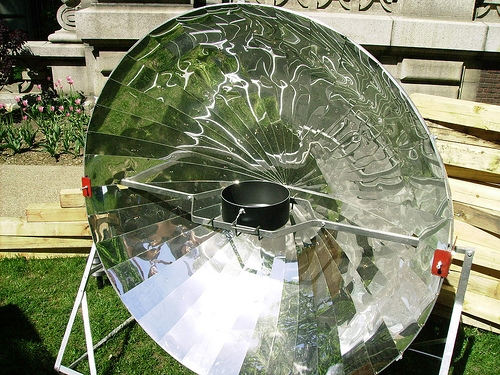
Love Lost and Hope Found at "Design for the Other 90%"
Text by Guest-Blogger Josh Wiese
Images by Starre Vartan and Josh Wiese
Have you ever just known that the person who’s call you’re eagerly awaiting is the one for you? I mean THE ONE. It’s this strange penetrating feeling you just can’t shake. You want to. It doesn’t make sense, I mean you just met.
I met her at a bar in the West Village on a Friday night. She was a friend of a friend, and we all hung out, sharing drinks, stories and laughs. Her stories were amazing, her soft smile and big eyes were irresistible. After a whole pitcher of margaritas with friends, we couldn’t help but get up from our table and dance. She told me about the view across the Hudson River at night, said it was beautiful, and we walked to the park.
We climbed over a berm and sat on the grass overlooking the water. I’ve never been more impressed with the soft glow of lights shining from the Jersey hills and those few lonely stars bright enough to cut through Manhattan’s night sky. It was a perfect evening with the perfect girl. I was lost in her eyes, lost in the moment. We kissed.
I fell in love that instant, and couldn’t wait to see her again. I’ve never been good in situations like this; I’m way too compulsive and eager. It seemed best to pace myself. The next day, just to let her know that she was in my thoughts, I sent a text. I waited. Checking my phone every five minutes, then every hour. No text back. I waited until Monday to call. No answer, but I left a message. No call back.
Thursday I called and left another message, this time suggesting a Saturday trip to check out the new exhibit at the Cooper-Hewitt Museum called “Design for the Other 90%“. The show looked really exciting: world-changing innovations, cool gadgets, and all with a humanitarian bent, it was totally up my alley. Finally, on Friday afternoon she sent a text saying that she’d call and meet me there. Yes! Saturday was going to be fantastic!
I made my way to the Upper East Side by around two on Saturday afternoon, but three o’clock came and no call. Three-thirty and then four p.m., still no call. Did she know the museum closed at six? Four-thrity, and I stood outside the museum grounds checking my phone again and again – nothing.
I was crushed. (Even the New York Times showed up!)
I sat on a bench, lost in my thoughts and tried to come up with excuses for why she didn’t call. Soon enough, excuses gave way to old fashion wallowing in self-despair. But here was still one hour left to check out the exhibit. So I sulked up to the ticket attendant, paid my twelve dollars, and walked slowly into the museum yard.
“Design for the other 90%” is an exhibit about the 5.8 billion people, or 90% of the world that have little or no access to most of the products and services many of us take for granted. They have no evening forays out to West Village bars, no manicured berms overlooking the Hudson River and Jersey shore, and bear the burden of much heavier worries than whether or not a certain beautiful girl will ever call them back. The exhibit takes a close look at some of the recent innovations designed to increase access to food and water, energy, education, healthcare, revenue-generating activities, and affordable transportation for those who need them most.
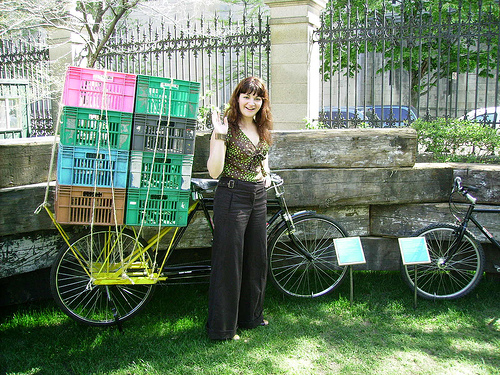
Worldbike prototype: helps the rider move large quantities over distances but it still safe and comfortable to ride. Hey, here’s a great way to fight global warming!
The exhibit is set up in the Cooper-Hewitt’s large garden lawn. It’s like a beautiful maze, and around every corner, set up as if it might be in the field and ready to use, a curious object or structure stands out, begging your attention.
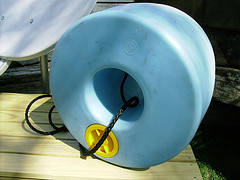
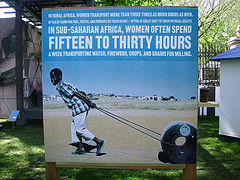
Instead of carrying water (a job that is primarily women’s and children’s work the world over, and can take several hours a day) people can now pull larger quantities in this heavy plastic wheel.
In spite my unshakable conviction that Friday evening was love at first site, and Saturday afternoon was love lost, my problems seemed to fade with each passing step. Every display told a story about overcoming a desperate situation. Every design was hope realized, and with each, my heart lifted.
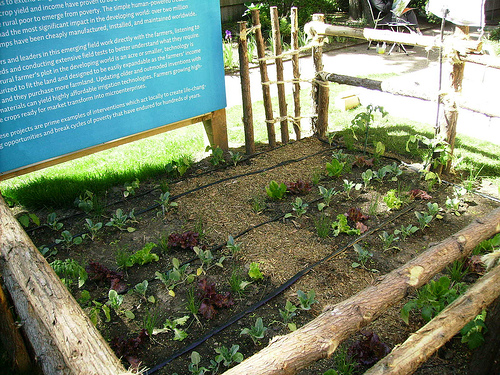
Drip irrigation systems hydrate plants more effectively and keep needed water from evaporating, preventing waste.
Inexpensive pumps and filters give life saving access to clean water and help efficiently irrigate crops. Easily installed virtual utilities combine street lighting for safety with a Wi-Fi mesh for communication and information. Paired with the advent of a 100$ laptop, isolated and poor schools are connected to the richest libraries in the world via the web. Cooking becomes safer and less expensive by using bicycle parts and vanity mirrors to build solar dishes that power informal kitchens. It’s amazing how much can be done with so little, and it’s all on display.
Some of what I saw was simple and familiar, but innovative in how it was applied to life in these communities. Some of it was complicated, totally new, but equally innovative in it’s application. “Design for the other 90%” is not about 10% of the worlds population coming to aid of the rest. It’s not about charity. It’s about designers working directly with the end users of their products, emphasizing co-creation to meet to their needs. According to the exhibit’s curator, “Many of these projects employ market principles for income generation as a way out of poverty. Poor rural farmers become micro-entrepreneurs, while cottage industries emerge in more urban areas. Some designs are patented to control the quality of their important breakthroughs, while others are open source in nature to allow for easier dissemination and adaptation, locally and internationally.”
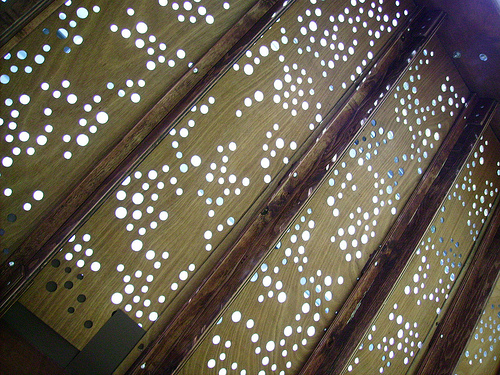
The underside of this lean-to roof (holes are for air-exchange) shows that design can be sustainable, beautiful, inexpensive and help people who need immediate shelter, all that the same time.
I spent the hour wandering around, reading about each exhibit piece, and the power of people coming to help one another. My spirits were lifted.
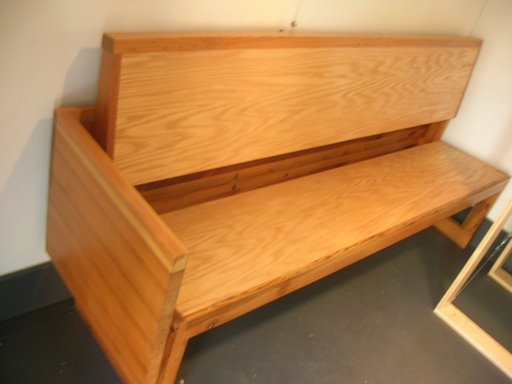
Bench made of reclaimed wood from Katrina-damaged homes.
In one afternoon I moved from heartbreak to inspiration, from self-despair to tears of hope. Yeah, it’s a little embarrassing, but they were actual tears. I’m not sure if the tears were the result of being left weak after a self-inflicted emotional roller coaster that I could have easily seen coming (unanswered texts and unreturned calls), or if it was the beautiful stories, one after another, told through each piece in the exhibit. Stories about hope and overcoming the senseless poverty that affects so many of our fellow sisters and brothers around the world. And while my love at first site never texted or called again after that, hope for other things, greater things, replaced that strange and penetrating feeling I just couldn’t shake.
For more images of the exhibit by Josh, go to Picasa.
For more images of the exhibit by Starre, go to Flickr.



